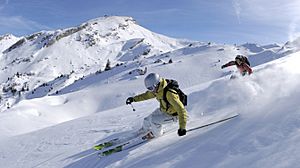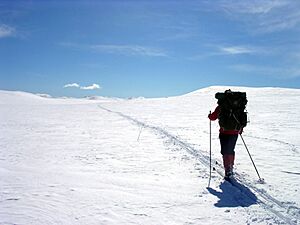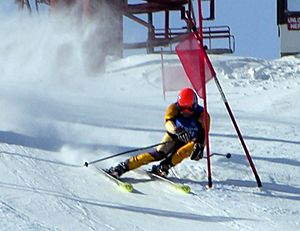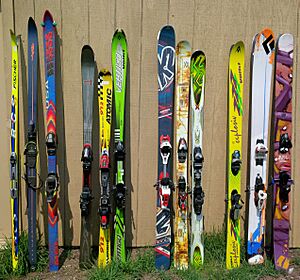Skiing facts for kids
Skiing is a fun way to move across snow using special long, flat pieces of equipment called skis. People ski for different reasons: as a way to travel, for fun, or as a competitive winter sport. Many skiing events are even part of the Winter Olympic Games!
History of Skiing
Skiing has been around for a very long time, almost 5,000 years! While modern skiing mostly comes from Scandinavia (countries like Norway and Sweden), some old paintings suggest people might have skied in what is now China over 10,000 years ago.
The word "ski" actually comes from Norway. It's from an old language called Old Norse, where "skíð" meant "split piece of wood" or "firewood."
In northern Finland and Sweden, people used different skis on each foot until the late 1800s. One ski was long and straight for gliding, and the other was shorter for pushing off. The short ski might have had animal skin on the bottom to help with pushing, while the long ski was greased with animal fat, much like how modern skis are waxed.
Early skiers used just one long pole or spear. The first time we see a picture of a skier with two ski poles was in 1741. By 1747, soldiers in Europe were using skis.
For a long time, skiing was mainly for transport. But by the mid-1800s, it also became a popular hobby and sport. Military ski races were held in Norway in the 1700s. As ski gear got better and ski lifts were invented, two main types of skiing became popular: Alpine (downhill) skiing and Nordic skiing. The biggest difference between them is how the ski boots attach to the skis.
Types of Skiing
Alpine Skiing
Alpine skiing is also known as "downhill skiing." It usually happens at a ski resort on specially prepared slopes called pistes. In Alpine skiing, your whole foot is attached to the ski, both at the toe and the heel. Ski lifts, like chairlifts, carry skiers up the mountain.
You can also go Backcountry skiing in untouched snow, sometimes reaching areas by helicopter, snowcat, hiking, or snowmobile. Ski resorts often have fun things like night skiing and glade skiing (skiing through trees) under the watchful eyes of the ski patrol. Alpine skiing became popular around the 1920s when ski lifts made it easy to go up the mountain without walking.
Nordic Skiing
Nordic skiing includes sports like cross-country skiing and ski jumping. In these types of skiing, only the toes of your boots are attached to the skis, so your heels can lift up.
Cross-country skiing can be done on groomed trails or in wild, undeveloped areas. Ski jumping, on the other hand, is done in special areas built just for jumping.
Telemark Skiing
Telemark skiing is a special way of turning while skiing. It's named after the Telemark region in Norway. It uses equipment similar to Nordic skiing, where only the toes of your boots are attached. This lets your heel lift up during turns, giving it a unique look.
Skiing Competitions
Many different types of skiing competitions are recognized by the International Ski Federation (FIS). Lots of these are also part of the Winter Olympic Games.
- Cross-country – This involves races over different distances on groomed trails. Skiers can use classic style (staying in tracks) or freestyle (skate-skiing). Major events include the FIS Cross-Country World Cup and the FIS Nordic World Ski Championships. Cross-country skiing has been in the Winter Olympics since 1924. This category also includes biathlon, which combines cross-country skiing with rifle shooting.
- Ski jumping – Skiers launch themselves off a ramp and try to fly as far as possible, landing smoothly. Competitions include the FIS Ski Jumping World Cup and the Winter Olympics. Ski jumping has been an Olympic sport since 1924.
- Freeriding – This type of skiing happens on natural, ungroomed terrain, often in deep snow.
- Nordic combined – This sport combines both cross-country skiing and ski jumping. It's featured at the FIS Nordic Combined World Cup and the Winter Olympics.
- Alpine skiing – This includes several downhill races: downhill, slalom, giant slalom, and super giant slalom (super-G). There are also "combined" events where skiers do one run of different types, like super-G and slalom. Alpine skiing is a big part of the FIS Alpine Ski World Cup and the Winter Olympics.
- Speed skiing – In this exciting sport, skiers try to go as fast as possible down a straight, steep slope. Records started in 1932, and it was even shown at the 1992 Winter Olympics.
- Freestyle skiing – This discipline is all about tricks and jumps! It includes events like mogul skiing (skiing over bumps), aerials (acrobatic jumps), ski cross (racing over a course with jumps and turns), half-pipe (skiing in a U-shaped snow structure), and slopestyle (skiing down a course with obstacles like rails and jumps). Freestyle skiing became an Olympic sport in 2014.
- Snowboarding – While not skiing, snowboarding is also a popular winter sport with many events like slopestyle, cross, and half-pipe. Snowboarding became an Olympic sport in 1998.
- Telemark – This is a newer competitive sport that mixes parts of Alpine and Nordic skiing. Races are held at the FIS Telemark World Cup.
- Grass skiing – Believe it or not, you can ski on grass! This started as a way to train for alpine skiing but is now its own sport.
Ski Gate
A ski gate is made of two poles that skiers must pass between during a race. Ski gates are used in Alpine skiing races like downhill, slalom, giant slalom, and super-G. Downhill races have fewer gates, allowing skiers to go very fast safely. If a skier misses a gate, they are usually removed from the race. Since the 1980s, many ski gates have hinges near the snow, making them safer. Some gates also have flags at the top.
Skiing Equipment
To go skiing, you need special gear:
- Skis: These are the long pieces you glide on. Some skis have special "skins" or textures for going uphill, or they are waxed to slide easily. Twin-tip skis are designed so you can ski forwards or backwards.
- Boots and bindings: Boots connect your feet to the skis using bindings.
- Poles: Used for balance and pushing.
- Helmets: Important for safety.
- Ski suits: Special clothing to keep you warm and dry.
- Ski goggles: To protect your eyes from snow and sun.
- Skiing gloves: To keep your hands warm.
Skiing Technique
How people ski has changed a lot as skis and technology have improved. Older ways of turning included the telemark turn, the stem, and the snowplough.
Newer skis, like those with a "parabolic" shape, have made it easier to do a modern turn called the carve turn.
Skiing on Other Surfaces
Even though skiing is mostly a winter sport, you can also ski without snow! This can happen indoors on special surfaces, outdoors on grass, on dry ski slopes, or using ski simulators. Some people even use roller skis on pavement. There are also treadmill-like machines that let you ski in one spot. Sand skiing is another unique way to ski, where people use regular ski gear to slide down sand dunes instead of snow.
Images for kids
-
A skier with a disability on a sit-ski, using two outriggers.
See also
 In Spanish: Esquí para niños
In Spanish: Esquí para niños










